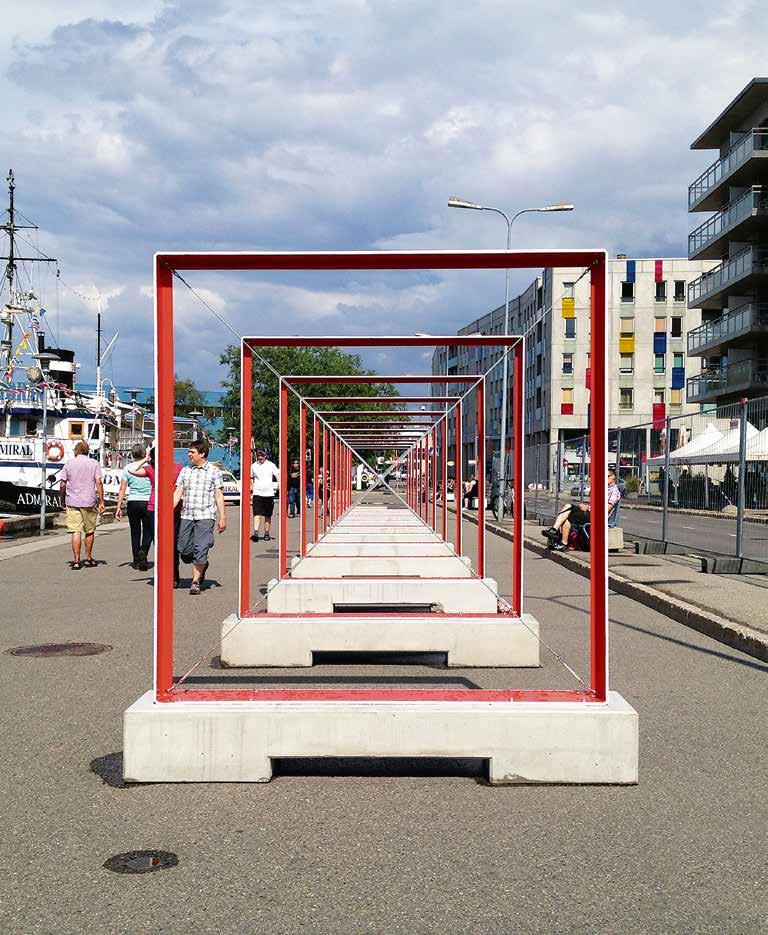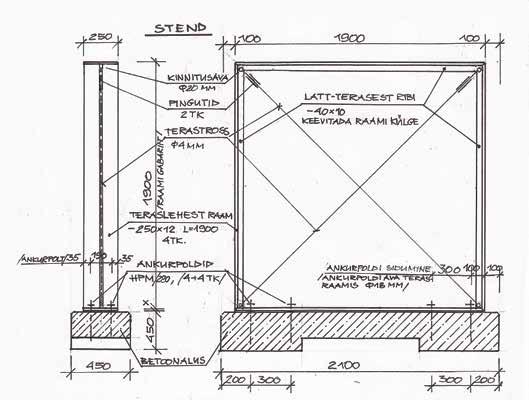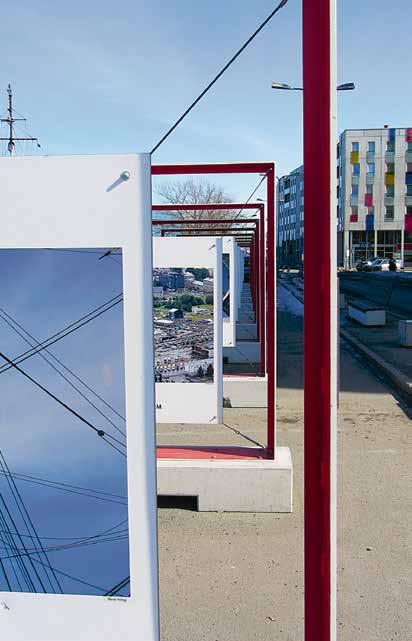
6 minute read
VÄLInÄITUSE STEndId
from RUUMIPILT 2012
Eesti Kunstiakadeemias kohtunud innovatiivne kolmik arhitekt Gert Sarv, sisearhitektid Loreida Hein ja Galina Burnakova on välja töötanud Tallinna Sadama kruiisituristide ala arhitektuurse lahenduse, City Marina restorani ja admiraliteedi basseini äärsete promenaadide ideeprojekti. Varasemas koostöös on valminud lahe, popp Katusekino lahendus.
The innovative threesome of architect Gert Sarv and interior architects Loreida Hein and Galina Burnakova met at the Estonian Academy of Arts. They have worked out the architectural solution for the cruise tourist area of Tallinn Harbour, the City Marina restaurant and the idea project for the promenades along the Admiralty Basin. The cool design for the pop Katusekino (Rooftop Cinema) is a previous project completed by this threesome.
Advertisement
outdoor Exhibition stands
autorid/authors:
tellija/client: teostus/implementation:
fotod/photos: Gert Sarv, Galina Burnakova,
Loreida Hein Tallinna Sadam
Stentmet, Kiili Betoon,
Projektgrupp Rosenberg
Loreida Hein, Kaido Haagen

lihtne universaalne vorm, ilus konstruktsiooniloogika ja asjalik teostus olid ka põhjuseks, miks žürii otsustas välinäituse stendi tootekujunduse preemiaga esile tõsta.
Tea Tammelaan, sisearhitekt ja ESLi aastapreemiate žürii liige
Vanasadama Admiraliteedi basseini tuulisel kaldapealsel püüab pilku arhitektuurne väikevorm: näitus linnaruumis. Praegu jalutab seal pigem turist kui linlane, kuid kiiresti muutuvas koosluses võib see olla peatselt vastupidi. Samuti mängivad stendid kätte ideaalse võimaluse rändnäituseks, miks mitte korrastada keskkonda samade näitusestendidega teises kontekstis. Või teha sealsamas arhitektuurinäitus.
Mis on selle näituse tekkelugu ja mis sündmustega see on seotud? Gert Sarv (GS): See näitus on osa sadamakai terviklahendusest, mille eskiisina välja pakkusime, kuid reaalselt on see ainuke asi, mida hetkel teostati, suurt pilti praegu teie ei näe. Kiire nagu alati, oli soov eelmise aasta Merepäevadeks näitus püsti saada. Kuraator pani fotomaterjali kokku ja plaanis on see uue teemaga välja vahetada, mis on seotud sadama või merendusega või kui linna poolt mõni mõte tekib, siis why not. Või pakkuda välja konsulaatidele, kes meil on – stendide arv klapib, Euroopa päevaks näiteks.
Milline oli tellija lähteülesanne? Galina Burnakova (GB): Mobiilsus eelkõige. Kui on vajadus, saab selle tõstukiga mõne teise terminali juurde liigutada, „kahvel” sõidab siia täpselt alla, selles mõte ongi. GS: Ja siis muidugi vandaalikindel, sügistuultekindel. arendasime siit raami mõtet, et pilt jääks hästi õhuliselt rippuma ja purjeefekti ei tekiks. Teine mõte oli see, et ta töötaks ka ilma piltideta n-ö iseseisva kahepoolse installatsioonina. Tekib perspektiiv. Metall on paks ja mahuline. Mõte on arenenud laevakere paksust metallist, kuidas see on värvitud – punane kärts toon – kõik need poid, pollarid ja kai servad. GB: Siiski mitte otseselt, mitte kitš. GS: betoonelement on selle tarbeks valatud, kogu teostus on väga hea.
See näitus on kohaspetsiifiline. Kuidas toimus suhestumine linnaga, merega, millised olid teie esimesed emotsioonid? GB: Kai oli pikk ja kitsas. Inimesed jalutavad siin nagu promenaadil. aga et nad lihtsalt ei jalutaks läbi, vaid peatuks korra, jälgiks midagi põnevat ja uut. GS: Suvel on see kõige aktiivsem keskkond admiraliteedi basseini ääres, City Marina restoran muidugi ka.
Siin liiguvad turistid. Kas linnainimene üldse siia jõuab? GS: Kui ükskord läheb käiku ka tühermaa täisehitamine, siis hakkab tervik moodustuma, praegu ei ole kuhugi suunduda, puudub suurem tõmbekeskus.
Kas see töö on olnud millegipoolest isemoodi? GS: See on väikeobjekti teema. Väga suurte objektide puhul, kus kipub kontroll detailide üle kaduma, tunnen ennast kuidagi ebakindlalt. GB: Sina oled klassikaline arhitekt nagu Corbu oli, teed maja ja kõik kuni ukselingini välja. Minu jaoks disain on disain. See on otse keskkonnas, ma olen seal palju hänginud, vanasti ei olnud siin palju midagi, tuled rattaga, sööd oma võiku ja... Kontseptuaalselt oli meie mõte tuua inimesed mere äärde. Kõik disainerid ja sündmused nagu Lift 11 on sellele viidanud. Peab olema väike põhjus minna mere äärde, linnainimesele pole palju vaja.


A small architectural form catches the eye on the windy embankment of the Old Harbour’s Admiralty Basin: an exhibition in open space in the city. Mostly tourists currently stroll about there instead of city residents but before long, that can turn around in the rapidly changing surroundings so that the opposite will be true. The stands also provide an ideal opportunity for a travelling exhibition. Why not spruce up the environment using those same exhibition stands in a different context? Or hold an architecture exhibition there?
How did this exhibition come about and what events is it connected to? Gert Sarv (GS): This exhibition is part of the overall design of the harbour quay, which we proposed as a preliminary sketch. This, however, is the only part of it that has thus far actually been implemented. You currently can’t see the big picture. This exhibition was wanted in time for last year’s Maritime Festival and so it was needed in a hurry. The curator put the photographic material together and there are plans to replace it with a new theme associated with the harbour or maritime affairs, or why not some other topic if the city comes up with a better idea. Or we could propose the idea to consulates here in Tallinn – the number of stands matches – to hold a festival celebrating Europe, for instance.
What was the original task from the customer? Galina Burnakova (GB): Mobility above all. If necessary, it can be moved by forklift to some other terminal. The “fork” fits under it exactly. That’s the whole point. GS: And then, of course, it’s vandalism-proof, and autumn wind-proof. From here, we developed the idea of the frame, so that the picture would remain hanging well and airily, and that the sail effect would be avoided. The other idea was that it would also work without pictures as an independent double-faced installation. It creates perspective. The metal is thick and fills a distinct volume. The idea developed from the thick metal of ship’s hulls, the way it is painted – a bright red tone – all those buoys, bollards and edges of the quay. GB: Not directly nevertheless, not kitsch. GS: The concrete element was poured for this purpose. The entire implementation is very good.
This exhibition is location specific. How did relating to the city and the sea take place? What were your first emotions? GB: The quay was long and narrow. People stroll here like on a promenade. But this is so that they wouldn’t simply stroll through but rather so that they would stop for a moment and observe something exciting and new. GS: This is the most active environment along the Admiralty Basin in the summer. The City Marina restaurant as well, of course.
This is a tourist area. Do city residents ever end up here? GS: When buildings finally start being erected on the surrounding vacant land, then a whole will start to be formed. Currently there’s nowhere to go from there, there is no large centre of attraction.
Was there anything different about this project? GS: This is the theme of a small object. I feel somewhat uncertain when working on very large objects, where you tend to lose control over details. GB: You are a classical architect like Corbu was. You design a building and everything right down to the door handles. For me, design is design. It’s right in the environment. I’ve hung out there quite a bit. Back then there wasn’t much to do here. You come here on your bike, eat your sandwich and…Conceptually, our idea was to bring people to the seaside. All designers and events like Lift 11 have referred to that. There has to be some kind of reason for going to the seaside, city residents don’t need much prodding.

Simple, universal form, attractive construction logic and practical implementation were the reasons why the jury decided to recognise the outdoor exhibition production design with an award.
Tea Tammelaan, interior architect and member of the ESL annual awards jury










